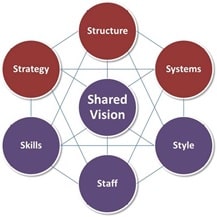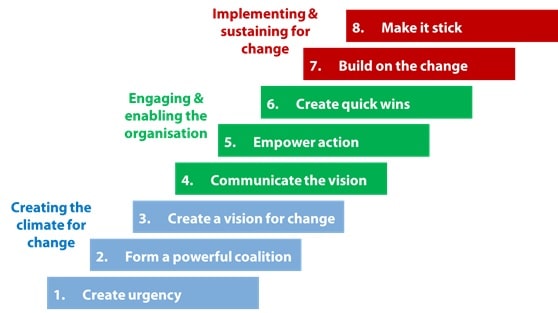HRMT440 Transformational Change Management Plan Sample Assignment
HRMT440-1604A-05 Key Assignment
Managing Organizational Change HRMT440-1604A-05
Week 2: Introduction
“Apple Inc. formed into a legal corporation on January 3, 1977. The company designs, manufactures and markets mobile communication and media devices, personal computers and portable digital music players and sells a variety of related software, services, peripherals, networking solutions and third-party digital content and applications. The Company's products and services include iPhone, iPad, Mac, iPod, Apple TV, a portfolio of consumer and professional software applications, the iOS and OS X operating systems, iCloud and a variety of accessory, service and support offerings.” (Apple.com, 2016).
Over the last decades or so, the iPhone has moved quite rapidly from the United States to Asia. China is a low-cost country, which is why it is believed that Apple is almost completely dependent on it for offshoring manufacturing. Offshoring is the practice of establishing a number of processes and/or services overseas because beneficial lower expenses.
Apple employs many people in the U.S. and because of offshoring many people lost their jobs. However, other stakeholders like investors continue to gain riches from it. Customers in the U.S. still have the availability of the products that the company provides, but have to wait longer than people in other countries for new products to emerge.
The reason Apple Inc. decided to start offshoring was because of money. Money is always the motive when the decision to offshore a company comes afloat. Several reasons include a quick growing local economy, which allows the business to be secure here and expand somewhere else. A stable global economy and low labor costs initiated Apple to make changes as well.
There is a lot of controversy because of this change. Some people agree with the implemented changes and others do not. Of Assignment only people who it affects negatively are the ones who believe offshoring is a mistake. Nevertheless, Apple continues to grow throughout different parts of the world.
Week 2: What is driving the need for transformation change?
Transformation change is “a shift in the business culture of an organization resulting from a change in the underlying strategy and processes that the organization has used in the past. A transformational change is designed to be organization-wide and is enacted over a period of time.” (Businessdictionary.com, 2016). In these terms, Apple’s decision to offshore was indeed a transformational change. The company simply used their current productions plans and implemented them in different parts of the world. By definition, this company has successfully moved their products to be made at a cheaper cost.
Apple Inc. is incredibly successful in the United States; they believe they have reached as many customers as they can here. Every time a new iPhone comes out the same customers rush over to the store, stand in line, and purchase their new iPhone. Loyal purchases have already been established here, which means it was time to look for new buyers thus creating more loyal customers in new places.
This transformational change depends on management to fully complete their role in making sure it all goes smoothly. For instance, making sure that every organizational affiliate and company stakeholders is well informed about the new business plan. They need to know about every strategy, what the overall mission is, and what type of production will be used in a new location.
It is of great importance to remain competitive in such a large and growing market. This is something that stakeholders are well aware of, they also know of different ways they can achieve this. However, offshoring proves to be very successful. Apple is incredibly dependent on offshoring because of extremely low cost of production.
Week 4: Theory of Change Management
In order for implementation of change to go along smoothly it is incredibly important that management is supportive and demonstrates it by communicating and interacting with staff. Other important aspects include; employee involvement, communication, getting rid of barriers, and making employees feel appreciated after the change has been successfully made.
There are a lot of change management models, but most companies choose 1) Lewin’s Change Management Model, 2)McKinsey 7-S Model or 3)Knotter’s 8 Step Change Model.
Lewin’s Change Management Model by Kurt Lewin
- Unfreeze – There needs to be a period of thawing or “unfreezing”
- Transition – Good leadership and motivation then helps ease the company successfully change.
- Refreeze – Once change is assumed then it refreezes with the new guidelines that were implemented.
Although his theory sounds great, people believe that it takes to long for companies to get used to the new way of things. Kurt’s theory has also received various amounts of criticism in regards to there not being enough time for the so called “freezing” part of the theory. Things are always changing and change is constant. A business cannot be constantly refreezing and freezing.
McKinsey 7-S Model by Robert Waterman, Tom Peters, Richard Pascale, and Anthony Athos

Pros
- It offers a successful method in producing a desired result to pinpoint and understand what an organization needs
- Allocates effective instructions in organizational change.
- Provides a combination of rational and emotional components.
- “All parts are integral and must be addressed in a unified manner.”
Cons
- Since all factors are interrelated, when one part changes it means all parts have to change as well.
- Ignored differences
- Has a complex model
- Higher incidence of failure
Kotter’s 8 Step Change Model by Harvard University Professor John Kotter

Pros:
- Model shows step-by-step what needs to be done
- The focus is not the actual change which makes it easier
- Transition is simpler
Cons:
- No skipping steps
- Long process
- Expensive
Week 4: Communication Plan
Anyone who is a part of the upcoming change needs to be told. “Some examples of key stakeholders are creditors, directors, employees, government (and its agencies), owners (shareholders), suppliers, unions, and the community from which the business draws its resources.” (Businessdictionary.com, 2016). Not only is it necessary for all leaders and employees to be completely aware of the activities that go on in a business, but it is also viewed as a tool to motivate everyone.
It is critical that all the information is explained correctly and carefully. If there is room left for a stakeholder to wonder, rumors can arise creating a negative outlook. When people do not have all the information they will fill in the blanks.
Typically leaders send out information because it is helpful to see them implementing the new changes. They must set a great example so that every employee feels eager to change.
There are many tools that we can use to communicate efficiently with. For example:
- instant messaging
- memos
- fax
- phone
- internet
- in person
`Week 5: Implementation Plan
Apple continues to succeed because they have always had a well-thought-out plan as to how to manage and implement changes. Their implementation process is made up of full awareness of the likely consequences and this helps them strategically plan so that they can achieve the mission objectives and organizational goals. When you are fully aware of what the possible setbacks can be you are able to choose whether or not the change is a benefit or not. It aids Apple in deciding what changes to make and what changes are better off undone.
“Changes must be able to achieve optimal results, which is why a formal detailed implementation plan must be created, communicated, and disseminated to all stakeholders” (Cummings, G., & Worley, C. G., 2005). Before even beginning to establish the intended goal there needs to be a period of careful considerations as to why there needs to be change, resources needs to be set up on a firm basis, and all stakeholders need to be on board. Key elements in Apple’s success are always including their stakeholders. They always communicate information effectively making it easier for their plan to run smooth.
When the decision of offshoring came afloat, stakeholders were skeptical. After several months of planning and discussing, the choice was made. The reason Apple Inc. decided to start offshoring was because they became aware of the amount of money it would bring in and how much they would be saving as well. Money was the entire motive and ultimately became the reason why they went through with the change. Several reasons include a quick growing local economy, which allows the business to be secure here and expand somewhere else. A stable global economy and low labor costs initiated Apple to make changes as well.
Finally, Apple still runs operations in China due to offshoring. The main reason it is functional is because before the decision ever even took place there were multiple meetings held and they were upfront as to why they wanted to offshore. Although many months passed by they have seen many benefits to continuing these operations. It took a while for all stakeholders to get on the same page, but it was accomplished.
References
Apple.com. (2016). About Apple Inc. Offshoring. Retrieved on October 14, 2016 from http://www.apple.com/about/
Businessdictionary.com (2016). Transformational change. Retrieved on October 17, 2016 from http://www.apple.com/about/http://www.businessdictionary.com/definition/transformational-change.html
Cerisano, R. (2014, June 6). Internal versus external consulting: Advantages and disadvantages. Retrieved from http://www.9lenses.com/internal-versus-external-consulting
Cummings, G., & Worley, C. G. (2005). Organizational development and change. Boston, MA: Cengage Learning.
Kotter’s 8-step model [Image]. (n.d.). Retrieved from http://tie575changemodel.wikispaces.com/Kotter%27s%208-step%20model
Nayab, N. (2014, October 24). How are you communicating to your team? Retrieved from http://www.brighthubpm.com/methods-strategies/79297-comparing-various-forms-of-communication
Schramm, W. (Ed.). (1954). The process and effects of mass communication. Urbana, IL: University of Illinois Press.
Senior, B., & Fleming, J. (2006). Organizational change. Upper Saddle River, NJ: Prentice Hall
Wikoff, D. (n.d.). How to communicate effectively within the change process. Retrieved from http://www.reliableplant.com/Read/23535/communicate-effectively-change-process
Williamson, G. (n.d.). The encode-decode model of communication. Retrieved from http://www.sltinfo.com/the-encode-decode-model-of-communication/


